Bitcoin, as a consensus, does not necessarily have to rely on a single dominant client software.
Written by: Liu Jiao Lian
Recently, a proposal to remove the size limit on additional data carried by OP_RETURN in the Bitcoin Core client has caused a stir in the industry. Typical proponents, such as developer Peter Todd, have repeatedly submitted PRs (Pull Requests), showing a determination to not give up until their goal is achieved.
On July 23, 2023, Peter Todd submitted PR#28130, proposing to remove the limit on data carried by OP_RETURN. The PR was closed and not adopted.
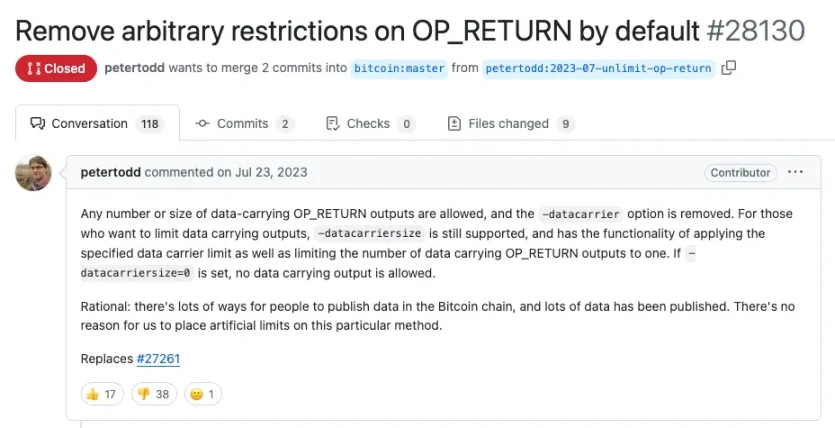
On April 28, 2025, he persisted and submitted the same proposal again, PR#32359. He aggressively demanded not only the removal of the additional data limit but also the deletion of the configuration option to prevent users of the client software from enabling the limit themselves.
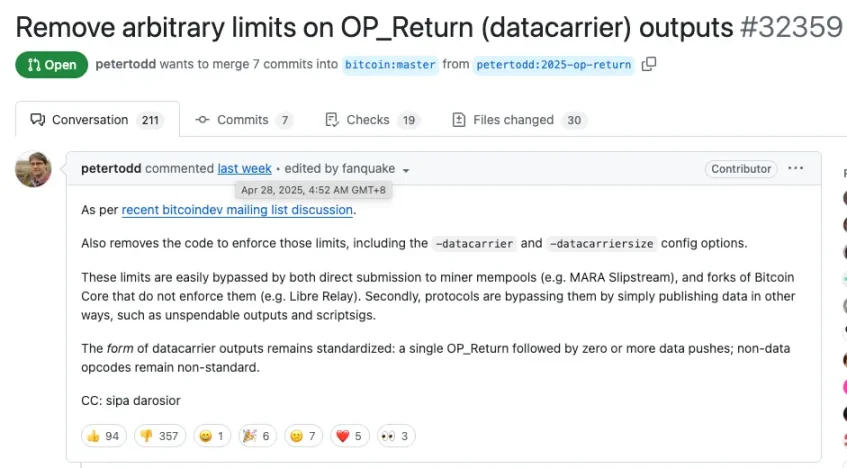
The proposal faced opposition from the majority.
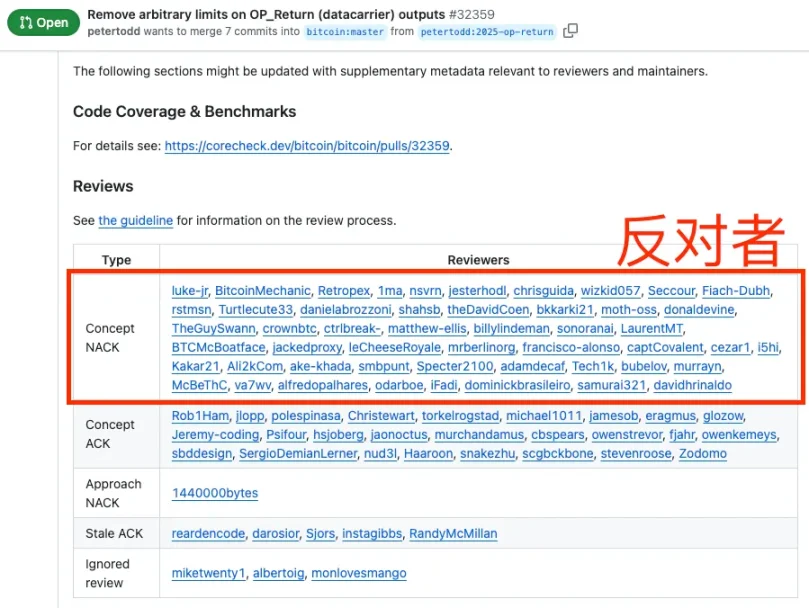
Another developer, instagibbs, proposed a slightly more moderate proposal, PR#32406. He suggested temporarily retaining the configuration option but with no default limit.

This proposal also received significant criticism. Instagibbs even wrote an explanation detailing the origins of OP_RETURN and why such a change was proposed.
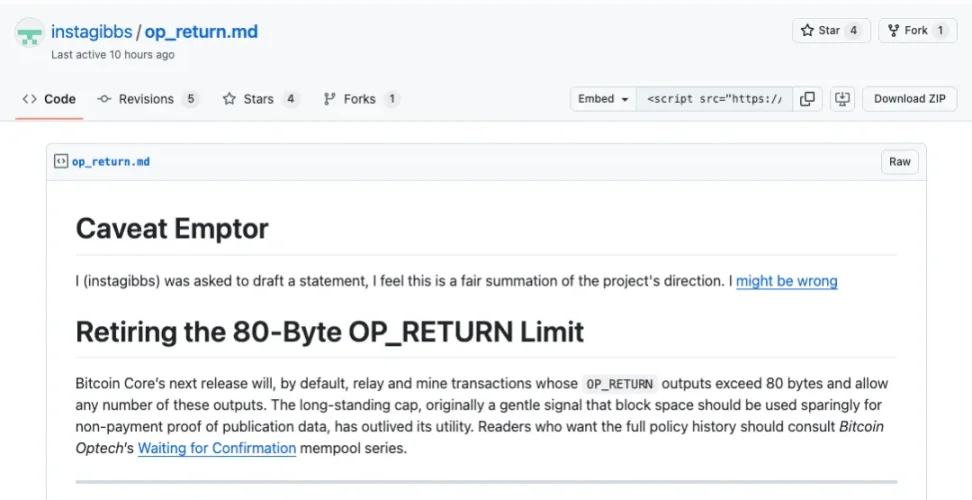
A typical opponent is developer Luke Dashjr. He is the maintainer of the Bitcoin Knots client software and was a fierce opponent of inscriptions two years ago. For more details, one can refer to previous articles by Jiao Lian.
For the average reader, a simple analogy to understand this issue could be:
Removing the additional data limit + Virtual machine execution of additional data = Ethereum
Of course, it is not that simple. Bitcoin's ledger is based on a stateless UTXO model, and modifying the ledger to store state data (which would lead to new issues like state explosion) would bring it closer to Ethereum's design.
In any case, it was precisely because Bitcoin Core rejected Vitalik Buterin's proposal to utilize the additional data capabilities of the Bitcoin ledger to realize his vision of smart contracts that he was compelled to establish Ethereum.
As for those betting on Ethereum to outperform BTC in this cycle, they must have quite a few wild animals racing through their minds.
Since this capability is merely a feature of the client software and not part of the Bitcoin protocol consensus, there is no need to worry that this controversy will lead to a hard fork like in 2017.
The main reasons for support include: many modified clients have already removed this limit and received support from certain mining pools; it may provide more incentives for miners; the ability to limit OP_RETURN cannot prevent people from cleverly using other capabilities like multisig or taproot scripts to carry data, and the restrictions may instead lead to fragmentation of UTXOs due to forced splitting and stitching of data; it is better to allow than to restrict, as there is no one-size-fits-all method to accurately identify what constitutes junk data, making it a futile cat-and-mouse game; and so on.
The main reasons for opposition include: lifting data restrictions could lead to rapid expansion of the Bitcoin ledger, thereby weakening decentralization; it could bring a large number of non-financial applications, diluting BTC's positioning and reducing it to a mere checkbook; and so on.
According to statistics from Clark Moddy Bitcoin, the current size of the Bitcoin blockchain is approximately 748.1GB, with OP_RETURN additional data accounting for about 3.83GB, or approximately 0.5%.
There is currently no definitive conclusion on whether the related PR will be merged and released. However, based on the community's voting with their feet, the number of nodes using the slimmed-down version of Bitcoin Knots has already surpassed the number of nodes running the latest version of Bitcoin Core 29.0.
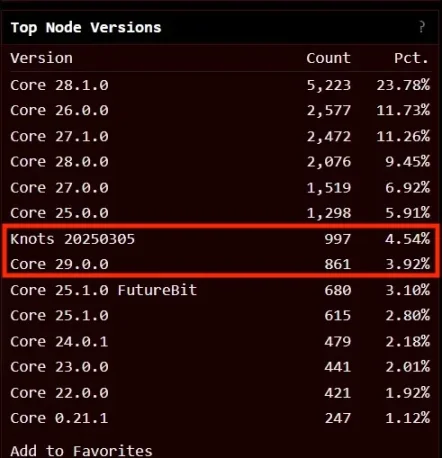
Perhaps we will witness a historic moment: Bitcoin, as a consensus, does not necessarily have to rely on a single dominant client software. (Although this has always been a fact, many people just have not realized it.)
A diversified Bitcoin ecosystem, with two to three equally matched Bitcoin client software, codebases, and development teams competing against each other, adhering to a set of Bitcoin consensus, harmoniously different yet not breaking apart, may actually better showcase the charm of Bitcoin's decentralization.
免责声明:本文章仅代表作者个人观点,不代表本平台的立场和观点。本文章仅供信息分享,不构成对任何人的任何投资建议。用户与作者之间的任何争议,与本平台无关。如网页中刊载的文章或图片涉及侵权,请提供相关的权利证明和身份证明发送邮件到support@aicoin.com,本平台相关工作人员将会进行核查。




